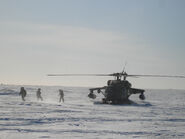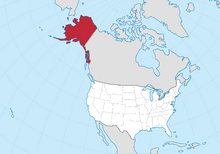| ||||||||
| Capital | Juneau | |||||||
| Largest City | Anchorage | |||||||
| Other Cities | Fairbanks, Nome, Point Barrow | |||||||
| Language Official |
English, Inupiat, Central Siberian Yupik, Central Alaskan Yup'ik, Alutiiq, Aleut, Dena'ina, Deg Xinag, Holikachuk, Koyukon, Upper Kuskokwim, Gwich'in, Lower Tanana, Upper Tanana, Tanacross, Hän, Ahtna, Eyak, Tlingit, Haida, Coast Tsimshian | |||||||
| Others | Alaska Native languages, Tagalog, Spanish | |||||||
| Ethnic Group | White American, Inuit, Siberian | |||||||
| Demonym | Alaskan | |||||||
| Legislature | Alaska Legislature | |||||||
| Area | 1,717,856 km² | |||||||
| Established | August 24, 1912 (Territory of Alaska) | |||||||
| Admission | January 3, 1959 | |||||||
| Abbreviations | AK | |||||||
Alaska is the 49th state of the United States of America located in the northwest of the North American continent. The state is bordered by Canada to the West and Russia to the East. It is largest state in the US. The tallest mountain of the United States, Mt McKinley, is located in the state.
History[]
Early History[]
It is widely believed that early humans coming from Eurasia crossed the Bering Strait during the Ice Age. These humans would then be the ancestors of the early Native Americans once they settled in the North American continent when the ice melted and waters rose.
Purchase of America[]
Alaska became a US territory following its purchase from the Russian Empire.
The 20th Century[]
The Aleutian Islands were briefly occupied by Japanese forces during World War II. The purpose of the invasion was to divert American naval forces fighting in Midway. With the Battle of Midway won by the United States, the Japanese were pushed out from the Aleutian Islands itself. It is noted that the Aleutian Islands campaign was one of the times a US territory, besides the Commonwealth of the Philippines, was occupied by an enemy force.
At beginning of the Cold War, the Territory of Alaska faced the biggest possibility of a Soviet invasion because of its proximity with the USSR. Recently declassified shows that former President Harry S Truman had laid out contingencies in case of an attack from the Soviet Union. In this plan, local populace and Inuit tribesmen would be armed to provide some sort of resistance to the Soviets, as well as gathering intelligence on enemy movements. These would have been laid out to regular US Army units for attacking enemy forces.
Alaska became a state in 1959, which was followed by the Territory of Hawaii in the same year.

Alaska Army National Guard soldiers conducting run-and-gun tactics against the Soviets.
World War III[]
Due to Alaska's proximity to the Soviet Union, it was attacked by Soviet bombers. The cities of Juneau, Fairbanks and Anchorage were targeted. Elmendorf Air Force Base was also attacked. On November 9, 1989, the state was invaded by Soviet forces. The Soviets were able to push to the center of the state but a joint US-Canadian force was able to stabilize the front lines, where the battle became a stalemate. The Soviets then asked the Chinese for reinforcements, which they promptly sent. Despite the reinforcements sent, this was not an easy task. They had to face joint US-Canadian forces that were scattered within the state. Local militia, police, native Inuits, CIA agents, and survivalists were attacking the Soviet and Chinese forces, often capturing their vehicles and using it against the communists. They would also play a part in reporting intel on enemy movements to US soldiers - which was considered to be very useful when combating the reds.
Economy[]
The State of Alaska has the Trans-Alaskan Pipeline. It is responsible for the transport of oil within the state and throughout all of North America. Alaska's main export product after oil, natural gas and lumber is seafood - primarily salmon, cod, Pollock and crab.
| ||||||||||||||||||




